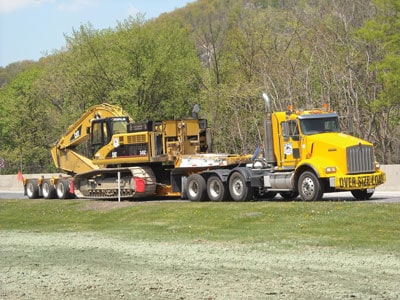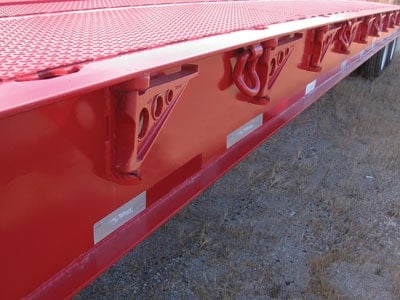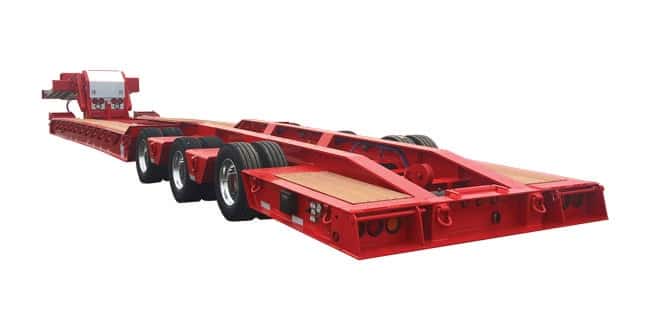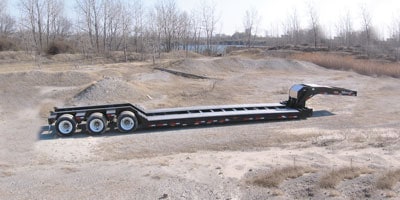A holistic approach to trailer total cost of ownership.
By Troy Geisler
Purchase price is the first and most obvious element of total cost of ownership, but simply glancing at a trailer’s price tag might only tell half the story. To really understand a trailer’s TCO, businesses need to look beyond the price tag. Here are seven factors businesses, fleet managers and independent operators should consider before their next trailer purchase to maximize their ROI.

#1: Capacity
A trailer must stand up to expected load capacities. But weight capacity ratings are not standardized and can lead to some confusion. The overall weight a trailer can handle is just that, whether a 35- or 55-ton lowbed. However, load concentration—or the length of the deck that can handle the weight—varies from one manufacturer to the next. For example, a 55-ton, 26-foot lowbed from Manufacturer A may need the entire deck length to safely carry the weight, while Manufacturer B only needs half the deck length for the same weight. Loads are rarely evenly distributed across the entire deck, so understanding concentrated load ratings for a particular trailer ensures operators are not overloading the trailer—decreasing safety and efficiency and racking up unnecessary maintenance costs.
#2: Axle Configurations
Laws and regulations vary from state to state, so it is important to choose a trailer that maximizes the load while minimizing permits. Working with a manufacturer that understands this helps to ensure the best possible weight distribution over the axles. Whether it is adding a fourth flip axle or spreading two or three additional axles apart to evenly accept the load, choosing axle configurations that offers more flexibility to handle different types of loads increases earning potential over the lifetime of the trailer.
#3: Safety Rating
The trailer’s safety rating is one of the quickest ways to determine if a manufacturer uses high-quality components—such as heavy-duty T-1 steel and Apitong flooring—that will stand up to the jobs you have planned. Safety ratings tell the end user how much magnification of payload the trailer is designed to withstand when driving over bumps and chuckholes. Safety ratings will range from 1.8 to 1—no margin—to up to 2.5 to 1, an industry high. A trailer with a high safety rating and built with high-quality materials may cost more up front, but will better stand up to the day-to-day stresses of hauling loads. Drivers should keep in mind that though the average magnification of payload is 1.8, in many instances the trailer will experience much more than that. A trailer designed with extra margin in the safety rating will experience less stress, wear and damage, resulting in reduced maintenance costs over time.

#4: Removable Gooseneck
In addition to profile and liftability, ease of use should be considered when selecting a removable gooseneck for optimum ROI. Industry-leading manufacturers offer hydraulic removable gooseneck systems that operate at 5 to 15 gpm, making them less susceptible to leaks. These low-pressure systems also use hoses that are readily available and more cost efficient than those needed for high-pressure systems. The location of the hydraulic system on the gooseneck can further increase ease of maintenance. Mounting the system within the gooseneck base section limits vibration and damage, increasing the length of maintenance intervals.
#5: Suspension Systems
A maintenance-friendly suspension system offers features designed specifically to increase its resilience and lifespan, as well as simplify the maintenance process when things do break down. Two things to look for are solid clamp-in bushings and extra-long contoured axle seats. Solid clamp-in bushings offer an extended life over slotted designs and easy replacement that does not require an expensive press. Extra-long, contoured axle seats reduce stress on the weld and provide a strong connection without the need of added U-bolts.
#6: Steel and Paint
Wear components are another thing to keep in mind. High-quality materials and finishes will last longer than traditional paints and lower-cost alternatives, especially for trailers that need to stand up to challenging conditions. Look for a trailer built with high-strength steel, such as 12-inch-deep I-beams with a minimum yield strength of 100,000 psi. This, along with premium primer and topcoat finishes, will ensure long-term durability.


#7: Ease of Maintenance
Some manufacturers design their trailers with maintenance points that are fast and easy to access, which is important for minimizing the time and money spent maintaining the unit. Look for cylinders that are mounted parallel to the ground that can be replaced in a matter of minutes, saving a significant amount of time and effort over the life of the trailer.
Looking Down the Road
The number on the price tag is important, but it is only the beginning for those looking to optimize their ROI with a smart investment. Trailers travel hundreds of thousands of miles—and a lot can happen between points A and B. To truly understand total cost of ownership, owners and operators must have a comprehensive understanding of what their trailer will cost in its lifetime, not just at the moment of purchase. A well-researched trailer investment can provide fast ROI and reliability that goes on for miles. | WA
Troy Geisler is the Vice President of Sales and Marketing for Talbert Manufacturing (Rensselaer, IN). He has more than 15 years of experience in trailer sales, including more than five years with Talbert. Talbert has been building world-class heavy-haul and specialized trailers to rigorous customer specifications since 1938. The company offers complete lines of heavy-haul trailers and specialized transportation equipment for the commercial, industrial, military and government sectors. Its trailers and equipment are used in applications as diverse as renewable energy, aerospace, heavy construction, in-plant material handling, manufacturing, and processing systems and much more. Troy can be reached at (219) 866-7141, e-mail t[email protected] or visit www.talbertmfg.com.
